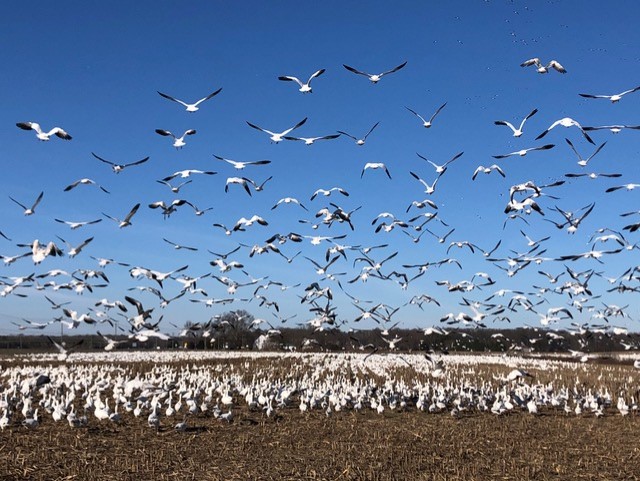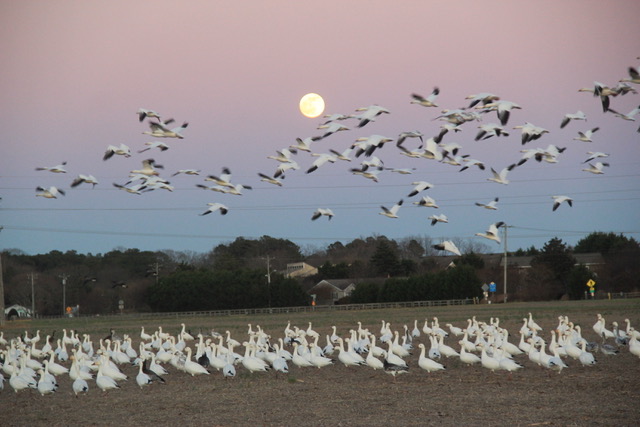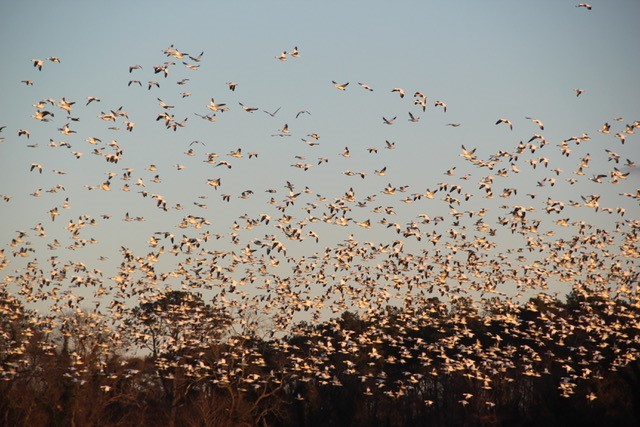Snow geese are majestic birds on the ground and in flight, but boy are they noisy! Just look at this video of them squawking in the air and squawk continues as they float gently into a cornfield.
The phenomenon of the snow geese takes place in the Mid-Atlantic during the fall and early winter (especially December and January) as they make their way south. Snow geese nest in the arctic tundra in the Summer and Winter in the southern part of the U.S. and Mexico. They migrate following the snow line so they can continue to eat along their migration route.
Delaware is one of their favorite stops along their journey. Prime Hook and Bombay Hook National Wildlife Preserves have been known to host more than 400,000 snow geese during that period. Gordon’s Pond hosts its share at times. But snow geese can be found in many other locations and fields around Lewes and Rehoboth including the plot of land near the new Beebe facility near Rt 24, across the street from Cape Henlopen High School and in a large field at the end of Holland Glade Road.

Most snow geese are chunky, white birds with black wingtips, a pink cone-shaped bill with a dark line along it, often called a “grinning patch,” and reddish-pink feet and legs. In some cases, the body of a snow goose is bluish-gray.
According to an article in Delmarva Almanac, the blue color morph is controlled by a single gene, with blue being partially dominant over white. If a blue snow goose mates with a white snow goose, their babies will be blue. If two white geese mate, they have only white offspring. If two blue geese mate, they will have mostly blue babies, with a few white ones, too.
Due to their sheer numbers, they can blanket an entire field while they feed. Startle them and it look like something exploded as they take to the sky. If your lucky, you might catch a flotilla of snow geese bobbing in the ocean.
Snow geese feed in shallow water and on the ground, typically in saturated soil, and they are voracious eaters. They will eat all parts of a plant from seeds, leaves, and stems to tubers and roots. They graze for seeds and grain above the ground and also grub around and rip up plants by the roots. In the winter, they feed on left over grain and new shoots on farmland.
They are vegetarians but they also are aggressive in nature and will run each other over to get to food.



The Audubon Society website contains some fascinating information about snow geese, including their mating and feeding habits, how they nurture their offspring and how climate change alter their migration habits. Audubon’s scientists have used 140 million bird observations to project how climate change will affect this bird’s range in the future.
Hunting snow geese, among other birds, is allowed in Delaware, Maryland and New Jersey. The website Del Bay Guide Service has details.
By Mary Jo Tarallo, Guest Journalist

Mary Jo Tarallo spent much of her career in public relations with various non-profits and spent 40 years involved with the ski industry as a journalist, public relations director for a national trade association and as executive director of the Learn to Ski and Snowboard initiative. Prior to her ski industry involvement she worked for the Maryland International Center in Baltimore and United Way of Central Maryland. She won a Gold Award for TV programming for a United Way simulcast that starred Oprah Winfrey. She has been cited for her work by numerous organizations. Mary Jo grew up in Baltimore, attended the University of Maryland and Towson University, lived in Washington, DC for 21 years and has been a full time resident of Rehoboth Beach and Milton since May 2019.